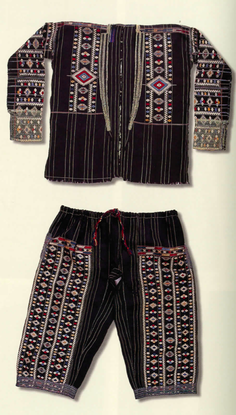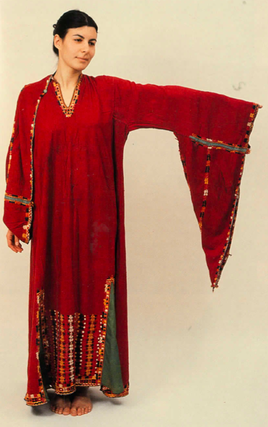If you are interested in having a traditional Jewish henna ceremony, for a marriage or for any other happy occasion, or interested in having me speak to a group about Jewish henna traditions, please contact me!
See here for an overview of Jewish henna traditions in general, and Jewish henna in Israel today.
This information is the result of my own research. Please do not copy this information without proper citation.
See here for an overview of Jewish henna traditions in general, and Jewish henna in Israel today.
This information is the result of my own research. Please do not copy this information without proper citation.
Jewish Henna Traditions among Kurdish Jews

Men's suit, Zakho, Iraqi Kurdistan.
Kurdish Jewish communities spanned the borders of Iraq, Iran, and even parts of Turkey and Syria. They were distinct from the other Jewish communities of the area, speaking various dialects of Judeo-(Neo-)Aramaic. In many ways, Kurdish Jewish communities share a common culture, despite their geographic boundaries, although there are still some differences between regional groups.
As among Persian and Iraqi Jews, henna was an important cosmetic, used to dye fingernails and hair for daily ornament. It was also used as decoration for holidays and special occasions. Jewish itinerant merchants peddled henna, among their other wares of cosmetics, jewelry, fabrics, and baubles, from village to village.
According to Erich Brauer, an early 20th century ethnographer of Kurdish Jews living in Jerusalem, there was a custom in some parts of Iraqi Kurdistan to hold a special henna ceremony (called khiyapit benatha, 'the bath of the maidens') the night before Purim, in memory of Esther and her bravery.
In Zakho and Amadiya, the women would take all the young maidens of the village to the baths, where they would be hennaed as if they were brides; they were given sweets and showered with rose petals and nuts, and their mothers told them that their henna made them as beautiful as Esther when she appeared before Ahasuerus.
As among Persian and Iraqi Jews, henna was an important cosmetic, used to dye fingernails and hair for daily ornament. It was also used as decoration for holidays and special occasions. Jewish itinerant merchants peddled henna, among their other wares of cosmetics, jewelry, fabrics, and baubles, from village to village.
According to Erich Brauer, an early 20th century ethnographer of Kurdish Jews living in Jerusalem, there was a custom in some parts of Iraqi Kurdistan to hold a special henna ceremony (called khiyapit benatha, 'the bath of the maidens') the night before Purim, in memory of Esther and her bravery.
In Zakho and Amadiya, the women would take all the young maidens of the village to the baths, where they would be hennaed as if they were brides; they were given sweets and showered with rose petals and nuts, and their mothers told them that their henna made them as beautiful as Esther when she appeared before Ahasuerus.
Henna was used to open the wedding festivities in Kurdish communities; small packages of henna would be sent by the family to all the friends and relatives, to invite them to the upcoming wedding. The henna would be delivered by elderly women who were responsible for remembering the names of all the invited guests. Generally the local aga [Muslim chieftain] would be invited as well, and his acceptance of the henna was seen as his symbolic permission to have the wedding take place.
The henna was kneaded in a large bowl (tashta) with tea or water, and sumac, which they called ḥamirit ḥinna, 'the fermenting [agent] for the henna'. The henna was left to 'ferment' overnight (because of this custom, henna was seen as being in the category of fermented items and thus forbidden on Passover; accordingly there was a custom among some Kurdish Jews to henna their hands, feet, and hair on the day before Passover, to 'use up' their henna before the holiday).
The henna night was generally known as lel ṣeva'ta or lel ṣuwa'ta, 'the night of dyeing'. According to Brauer, in Zakho there were two henna nights — the ‘false henna night’ on the Thursday before the wedding, and the 'true' henna night the night before. Both the bride and the groom were hennaed, and like in India, a small child would be hennaed first as a 'decoy' to confuse the Evil Eye.
The henna was kneaded in a large bowl (tashta) with tea or water, and sumac, which they called ḥamirit ḥinna, 'the fermenting [agent] for the henna'. The henna was left to 'ferment' overnight (because of this custom, henna was seen as being in the category of fermented items and thus forbidden on Passover; accordingly there was a custom among some Kurdish Jews to henna their hands, feet, and hair on the day before Passover, to 'use up' their henna before the holiday).
The henna night was generally known as lel ṣeva'ta or lel ṣuwa'ta, 'the night of dyeing'. According to Brauer, in Zakho there were two henna nights — the ‘false henna night’ on the Thursday before the wedding, and the 'true' henna night the night before. Both the bride and the groom were hennaed, and like in India, a small child would be hennaed first as a 'decoy' to confuse the Evil Eye.
|
In former years, it was traditional for the groom to henna his hands, feet, and sidelocks (peyot, or gulage in the local dialect), but in more recent times grooms preferred to henna only their palms.
In Sandor, a Jewish village in northern Iraqi Kurdistan, they practiced a unique form of dough resist to create patterns in the henna. The women would make a simple flour-and-water dough and roll it out into thin threads. The threads would be arranged on the hands in designs: a crescent in the centre of the palm, stars around it, and spirals on the fingers. The henna would then be spread over it and wrapped in cloth, and when it was removed the designs shone through in the natural skin colour against the bright red of the henna. The morning following the henna ceremony, the bride and groom were taken (separately) down to the nearest river in a celebratory procession to bathe, and then were dressed in their wedding finery. |
In the past, as Brauer records, it was customary in Zakho and Amadiya to henna the body of a young man or woman who had died before their marriage. The traditional wedding songs are sung, and if they were betrothed, their fiancé or fiancée would sometimes sit with the body, dressed in their wedding finery. This is no longer practiced today.
In Israel today, Kurdish Jews still practice their henna ceremonies for weddings, but in a simplified fashion and assimilated to the Israeli model. The traditional patterns are no longer done, and the henna traditions for Purim, Passover, and other occasions seem to have entirely vanished.
In Israel today, Kurdish Jews still practice their henna ceremonies for weddings, but in a simplified fashion and assimilated to the Israeli model. The traditional patterns are no longer done, and the henna traditions for Purim, Passover, and other occasions seem to have entirely vanished.
Sources and References:
Brauer, Erich. 1947 Yehudei Kurdistan: meḥqar etnologi [The Jews of Kurdistan: ethnological research]. Completed and edited by Raphael Patai.
Brawer, Abraham. 1945 ’Avaq derakhim: masa’ beParas [The dust from roads: a journey in Persia].
Garbell, Irene. 1965 The Jewish Neo-Aramaic Dialect of Persian Azerbaijan: linguistic analysis and folkloristic texts.
Mutzafi, Hezy. 2008 The Jewish Neo-Aramaic Dialect of Betanure (province of Dihok).
Shai, Donna. 1974 Wedding Customs among Kurdish Jews in (Zakho) Kurdistan and in (Jerusalem) Israel. In Studies in Marriage Customs, ed. by Issachar Ben-Ami and Dov Noy.
Brawer, Abraham. 1945 ’Avaq derakhim: masa’ beParas [The dust from roads: a journey in Persia].
Garbell, Irene. 1965 The Jewish Neo-Aramaic Dialect of Persian Azerbaijan: linguistic analysis and folkloristic texts.
Mutzafi, Hezy. 2008 The Jewish Neo-Aramaic Dialect of Betanure (province of Dihok).
Shai, Donna. 1974 Wedding Customs among Kurdish Jews in (Zakho) Kurdistan and in (Jerusalem) Israel. In Studies in Marriage Customs, ed. by Issachar Ben-Ami and Dov Noy.
Pictures from:
Schwartz-Be'eri, Ora. 2000 The Jews of Kurdistan: daily life, customs, arts and crafts.
